Effective Communication Strategies for Managing Organisational Change
VerifiedAdded on 2023/06/13
|8
|2935
|371
AI Summary
This essay analyses how managers can use communication theories for effectively managing an organisational change. It discusses the importance of effective communication in establishing a positive working environment and retaining skilled employees. The essay also provides recommendations for managers to implement effective communication strategies at their workplace in order to avoid workplace disputes and implement a positive working environment. The subject is business communication and the course code is not mentioned. The college/university is not mentioned.
Contribute Materials
Your contribution can guide someone’s learning journey. Share your
documents today.
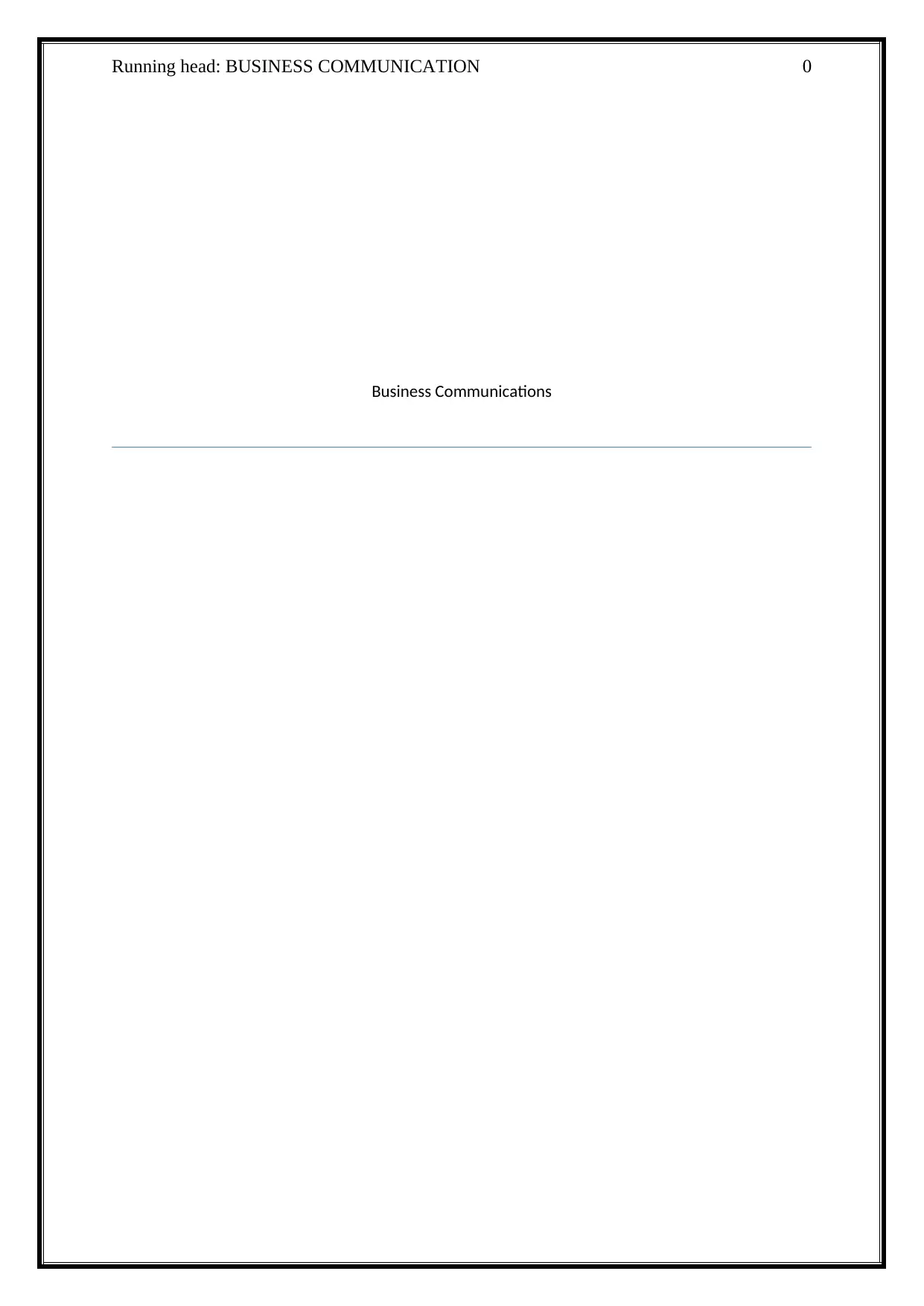
Running head: BUSINESS COMMUNICATION 0
Business Communications
Business Communications
Secure Best Marks with AI Grader
Need help grading? Try our AI Grader for instant feedback on your assignments.
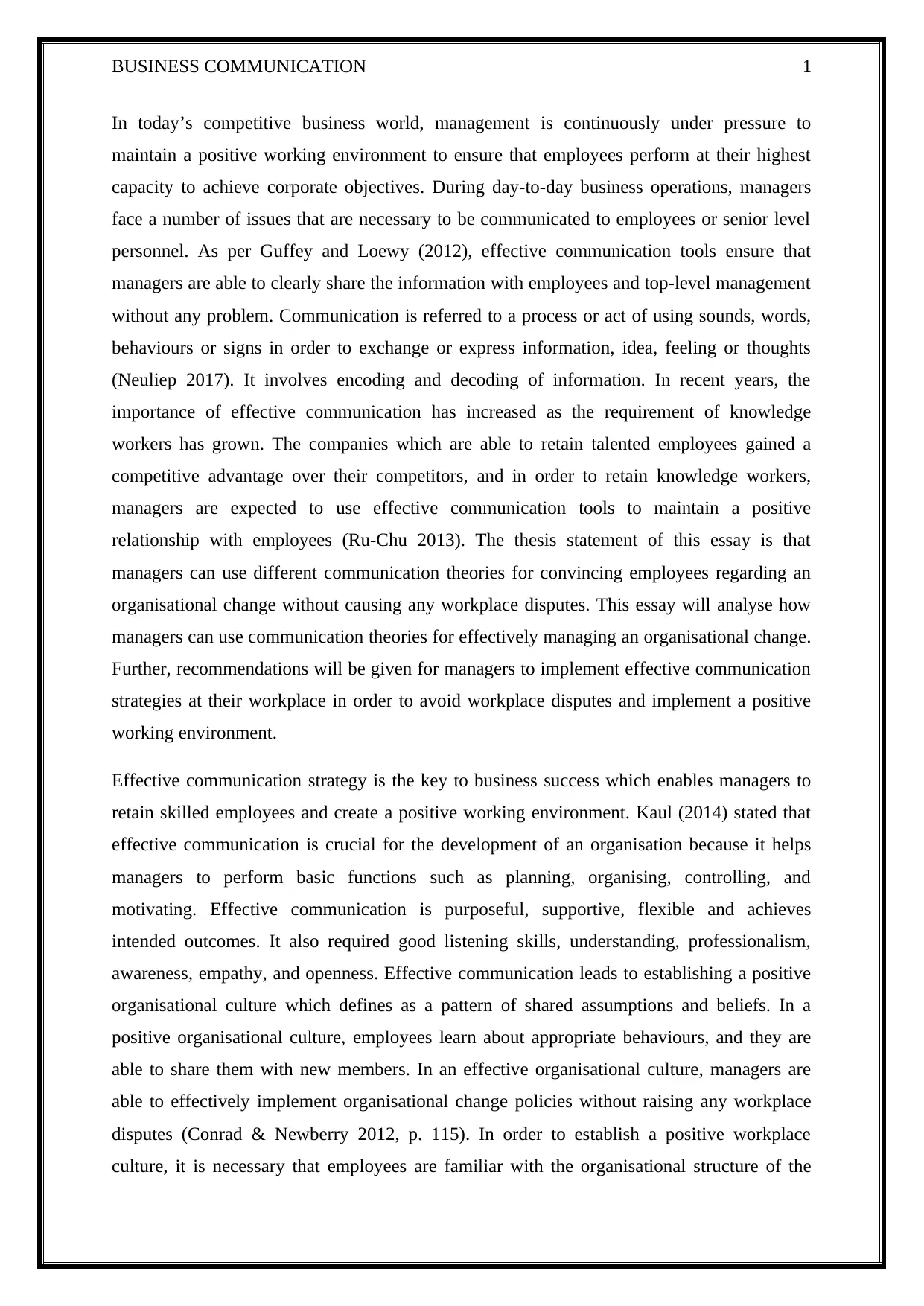
BUSINESS COMMUNICATION 1
In today’s competitive business world, management is continuously under pressure to
maintain a positive working environment to ensure that employees perform at their highest
capacity to achieve corporate objectives. During day-to-day business operations, managers
face a number of issues that are necessary to be communicated to employees or senior level
personnel. As per Guffey and Loewy (2012), effective communication tools ensure that
managers are able to clearly share the information with employees and top-level management
without any problem. Communication is referred to a process or act of using sounds, words,
behaviours or signs in order to exchange or express information, idea, feeling or thoughts
(Neuliep 2017). It involves encoding and decoding of information. In recent years, the
importance of effective communication has increased as the requirement of knowledge
workers has grown. The companies which are able to retain talented employees gained a
competitive advantage over their competitors, and in order to retain knowledge workers,
managers are expected to use effective communication tools to maintain a positive
relationship with employees (Ru-Chu 2013). The thesis statement of this essay is that
managers can use different communication theories for convincing employees regarding an
organisational change without causing any workplace disputes. This essay will analyse how
managers can use communication theories for effectively managing an organisational change.
Further, recommendations will be given for managers to implement effective communication
strategies at their workplace in order to avoid workplace disputes and implement a positive
working environment.
Effective communication strategy is the key to business success which enables managers to
retain skilled employees and create a positive working environment. Kaul (2014) stated that
effective communication is crucial for the development of an organisation because it helps
managers to perform basic functions such as planning, organising, controlling, and
motivating. Effective communication is purposeful, supportive, flexible and achieves
intended outcomes. It also required good listening skills, understanding, professionalism,
awareness, empathy, and openness. Effective communication leads to establishing a positive
organisational culture which defines as a pattern of shared assumptions and beliefs. In a
positive organisational culture, employees learn about appropriate behaviours, and they are
able to share them with new members. In an effective organisational culture, managers are
able to effectively implement organisational change policies without raising any workplace
disputes (Conrad & Newberry 2012, p. 115). In order to establish a positive workplace
culture, it is necessary that employees are familiar with the organisational structure of the
In today’s competitive business world, management is continuously under pressure to
maintain a positive working environment to ensure that employees perform at their highest
capacity to achieve corporate objectives. During day-to-day business operations, managers
face a number of issues that are necessary to be communicated to employees or senior level
personnel. As per Guffey and Loewy (2012), effective communication tools ensure that
managers are able to clearly share the information with employees and top-level management
without any problem. Communication is referred to a process or act of using sounds, words,
behaviours or signs in order to exchange or express information, idea, feeling or thoughts
(Neuliep 2017). It involves encoding and decoding of information. In recent years, the
importance of effective communication has increased as the requirement of knowledge
workers has grown. The companies which are able to retain talented employees gained a
competitive advantage over their competitors, and in order to retain knowledge workers,
managers are expected to use effective communication tools to maintain a positive
relationship with employees (Ru-Chu 2013). The thesis statement of this essay is that
managers can use different communication theories for convincing employees regarding an
organisational change without causing any workplace disputes. This essay will analyse how
managers can use communication theories for effectively managing an organisational change.
Further, recommendations will be given for managers to implement effective communication
strategies at their workplace in order to avoid workplace disputes and implement a positive
working environment.
Effective communication strategy is the key to business success which enables managers to
retain skilled employees and create a positive working environment. Kaul (2014) stated that
effective communication is crucial for the development of an organisation because it helps
managers to perform basic functions such as planning, organising, controlling, and
motivating. Effective communication is purposeful, supportive, flexible and achieves
intended outcomes. It also required good listening skills, understanding, professionalism,
awareness, empathy, and openness. Effective communication leads to establishing a positive
organisational culture which defines as a pattern of shared assumptions and beliefs. In a
positive organisational culture, employees learn about appropriate behaviours, and they are
able to share them with new members. In an effective organisational culture, managers are
able to effectively implement organisational change policies without raising any workplace
disputes (Conrad & Newberry 2012, p. 115). In order to establish a positive workplace
culture, it is necessary that employees are familiar with the organisational structure of the
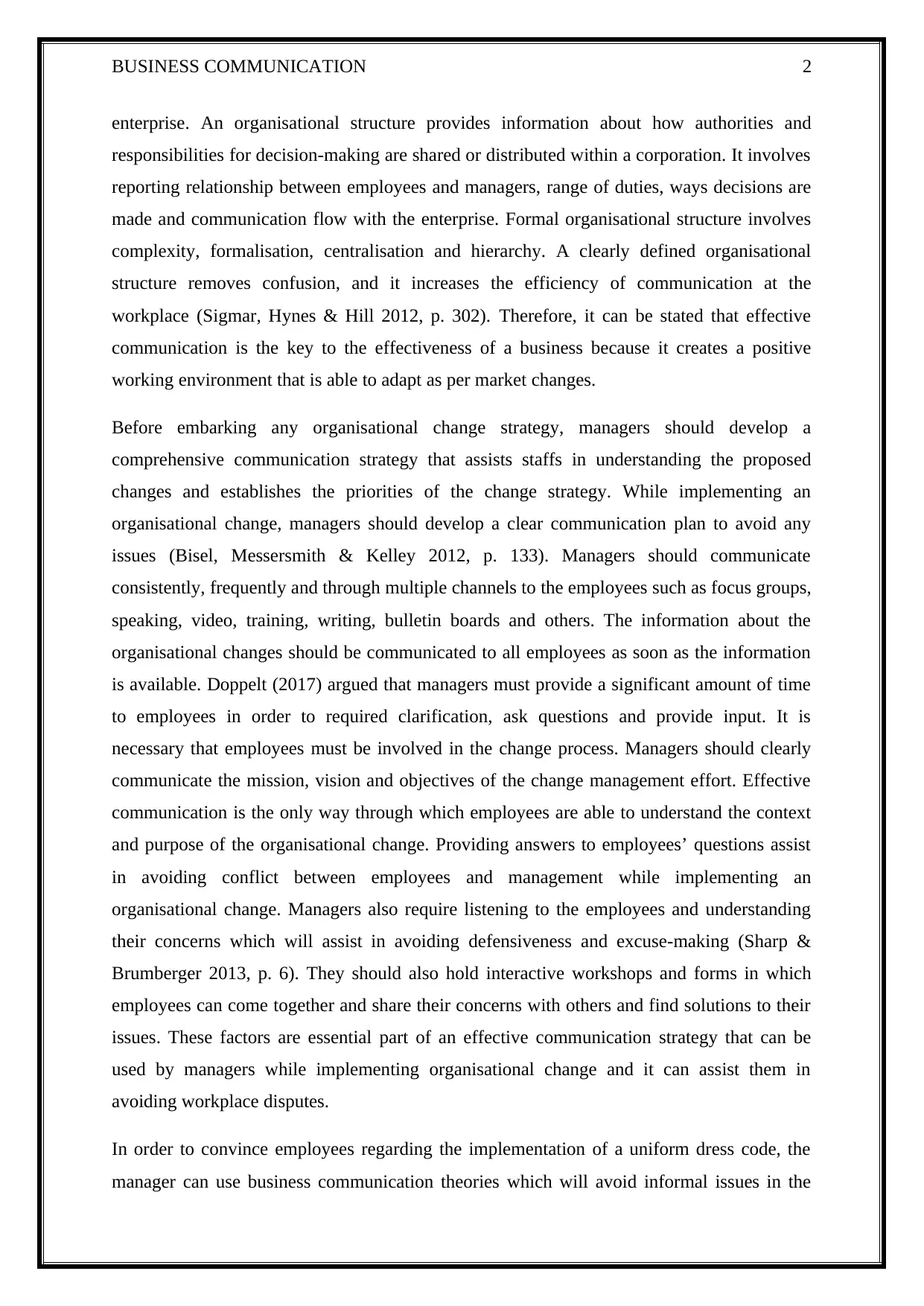
BUSINESS COMMUNICATION 2
enterprise. An organisational structure provides information about how authorities and
responsibilities for decision-making are shared or distributed within a corporation. It involves
reporting relationship between employees and managers, range of duties, ways decisions are
made and communication flow with the enterprise. Formal organisational structure involves
complexity, formalisation, centralisation and hierarchy. A clearly defined organisational
structure removes confusion, and it increases the efficiency of communication at the
workplace (Sigmar, Hynes & Hill 2012, p. 302). Therefore, it can be stated that effective
communication is the key to the effectiveness of a business because it creates a positive
working environment that is able to adapt as per market changes.
Before embarking any organisational change strategy, managers should develop a
comprehensive communication strategy that assists staffs in understanding the proposed
changes and establishes the priorities of the change strategy. While implementing an
organisational change, managers should develop a clear communication plan to avoid any
issues (Bisel, Messersmith & Kelley 2012, p. 133). Managers should communicate
consistently, frequently and through multiple channels to the employees such as focus groups,
speaking, video, training, writing, bulletin boards and others. The information about the
organisational changes should be communicated to all employees as soon as the information
is available. Doppelt (2017) argued that managers must provide a significant amount of time
to employees in order to required clarification, ask questions and provide input. It is
necessary that employees must be involved in the change process. Managers should clearly
communicate the mission, vision and objectives of the change management effort. Effective
communication is the only way through which employees are able to understand the context
and purpose of the organisational change. Providing answers to employees’ questions assist
in avoiding conflict between employees and management while implementing an
organisational change. Managers also require listening to the employees and understanding
their concerns which will assist in avoiding defensiveness and excuse-making (Sharp &
Brumberger 2013, p. 6). They should also hold interactive workshops and forms in which
employees can come together and share their concerns with others and find solutions to their
issues. These factors are essential part of an effective communication strategy that can be
used by managers while implementing organisational change and it can assist them in
avoiding workplace disputes.
In order to convince employees regarding the implementation of a uniform dress code, the
manager can use business communication theories which will avoid informal issues in the
enterprise. An organisational structure provides information about how authorities and
responsibilities for decision-making are shared or distributed within a corporation. It involves
reporting relationship between employees and managers, range of duties, ways decisions are
made and communication flow with the enterprise. Formal organisational structure involves
complexity, formalisation, centralisation and hierarchy. A clearly defined organisational
structure removes confusion, and it increases the efficiency of communication at the
workplace (Sigmar, Hynes & Hill 2012, p. 302). Therefore, it can be stated that effective
communication is the key to the effectiveness of a business because it creates a positive
working environment that is able to adapt as per market changes.
Before embarking any organisational change strategy, managers should develop a
comprehensive communication strategy that assists staffs in understanding the proposed
changes and establishes the priorities of the change strategy. While implementing an
organisational change, managers should develop a clear communication plan to avoid any
issues (Bisel, Messersmith & Kelley 2012, p. 133). Managers should communicate
consistently, frequently and through multiple channels to the employees such as focus groups,
speaking, video, training, writing, bulletin boards and others. The information about the
organisational changes should be communicated to all employees as soon as the information
is available. Doppelt (2017) argued that managers must provide a significant amount of time
to employees in order to required clarification, ask questions and provide input. It is
necessary that employees must be involved in the change process. Managers should clearly
communicate the mission, vision and objectives of the change management effort. Effective
communication is the only way through which employees are able to understand the context
and purpose of the organisational change. Providing answers to employees’ questions assist
in avoiding conflict between employees and management while implementing an
organisational change. Managers also require listening to the employees and understanding
their concerns which will assist in avoiding defensiveness and excuse-making (Sharp &
Brumberger 2013, p. 6). They should also hold interactive workshops and forms in which
employees can come together and share their concerns with others and find solutions to their
issues. These factors are essential part of an effective communication strategy that can be
used by managers while implementing organisational change and it can assist them in
avoiding workplace disputes.
In order to convince employees regarding the implementation of a uniform dress code, the
manager can use business communication theories which will avoid informal issues in the
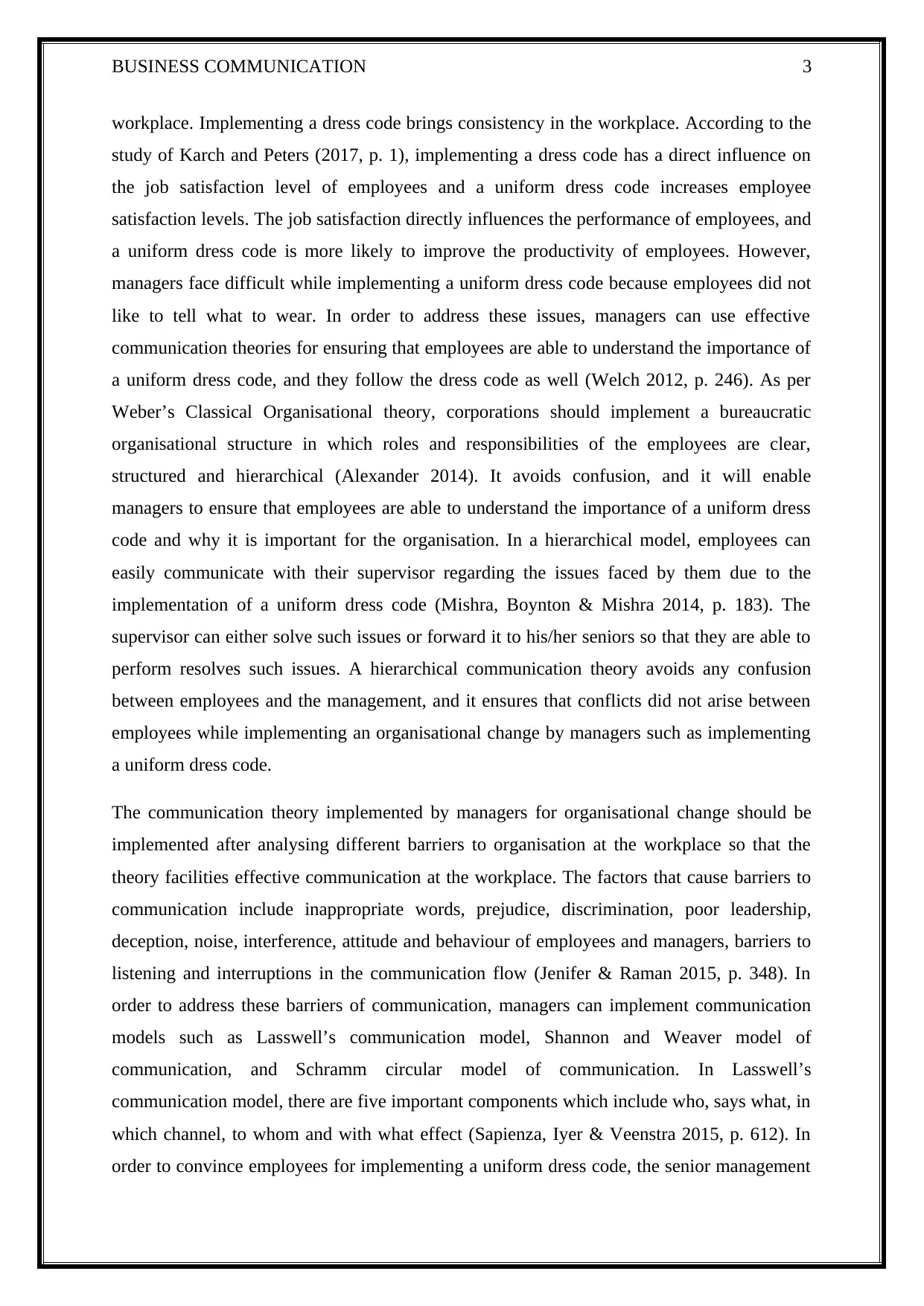
BUSINESS COMMUNICATION 3
workplace. Implementing a dress code brings consistency in the workplace. According to the
study of Karch and Peters (2017, p. 1), implementing a dress code has a direct influence on
the job satisfaction level of employees and a uniform dress code increases employee
satisfaction levels. The job satisfaction directly influences the performance of employees, and
a uniform dress code is more likely to improve the productivity of employees. However,
managers face difficult while implementing a uniform dress code because employees did not
like to tell what to wear. In order to address these issues, managers can use effective
communication theories for ensuring that employees are able to understand the importance of
a uniform dress code, and they follow the dress code as well (Welch 2012, p. 246). As per
Weber’s Classical Organisational theory, corporations should implement a bureaucratic
organisational structure in which roles and responsibilities of the employees are clear,
structured and hierarchical (Alexander 2014). It avoids confusion, and it will enable
managers to ensure that employees are able to understand the importance of a uniform dress
code and why it is important for the organisation. In a hierarchical model, employees can
easily communicate with their supervisor regarding the issues faced by them due to the
implementation of a uniform dress code (Mishra, Boynton & Mishra 2014, p. 183). The
supervisor can either solve such issues or forward it to his/her seniors so that they are able to
perform resolves such issues. A hierarchical communication theory avoids any confusion
between employees and the management, and it ensures that conflicts did not arise between
employees while implementing an organisational change by managers such as implementing
a uniform dress code.
The communication theory implemented by managers for organisational change should be
implemented after analysing different barriers to organisation at the workplace so that the
theory facilities effective communication at the workplace. The factors that cause barriers to
communication include inappropriate words, prejudice, discrimination, poor leadership,
deception, noise, interference, attitude and behaviour of employees and managers, barriers to
listening and interruptions in the communication flow (Jenifer & Raman 2015, p. 348). In
order to address these barriers of communication, managers can implement communication
models such as Lasswell’s communication model, Shannon and Weaver model of
communication, and Schramm circular model of communication. In Lasswell’s
communication model, there are five important components which include who, says what, in
which channel, to whom and with what effect (Sapienza, Iyer & Veenstra 2015, p. 612). In
order to convince employees for implementing a uniform dress code, the senior management
workplace. Implementing a dress code brings consistency in the workplace. According to the
study of Karch and Peters (2017, p. 1), implementing a dress code has a direct influence on
the job satisfaction level of employees and a uniform dress code increases employee
satisfaction levels. The job satisfaction directly influences the performance of employees, and
a uniform dress code is more likely to improve the productivity of employees. However,
managers face difficult while implementing a uniform dress code because employees did not
like to tell what to wear. In order to address these issues, managers can use effective
communication theories for ensuring that employees are able to understand the importance of
a uniform dress code, and they follow the dress code as well (Welch 2012, p. 246). As per
Weber’s Classical Organisational theory, corporations should implement a bureaucratic
organisational structure in which roles and responsibilities of the employees are clear,
structured and hierarchical (Alexander 2014). It avoids confusion, and it will enable
managers to ensure that employees are able to understand the importance of a uniform dress
code and why it is important for the organisation. In a hierarchical model, employees can
easily communicate with their supervisor regarding the issues faced by them due to the
implementation of a uniform dress code (Mishra, Boynton & Mishra 2014, p. 183). The
supervisor can either solve such issues or forward it to his/her seniors so that they are able to
perform resolves such issues. A hierarchical communication theory avoids any confusion
between employees and the management, and it ensures that conflicts did not arise between
employees while implementing an organisational change by managers such as implementing
a uniform dress code.
The communication theory implemented by managers for organisational change should be
implemented after analysing different barriers to organisation at the workplace so that the
theory facilities effective communication at the workplace. The factors that cause barriers to
communication include inappropriate words, prejudice, discrimination, poor leadership,
deception, noise, interference, attitude and behaviour of employees and managers, barriers to
listening and interruptions in the communication flow (Jenifer & Raman 2015, p. 348). In
order to address these barriers of communication, managers can implement communication
models such as Lasswell’s communication model, Shannon and Weaver model of
communication, and Schramm circular model of communication. In Lasswell’s
communication model, there are five important components which include who, says what, in
which channel, to whom and with what effect (Sapienza, Iyer & Veenstra 2015, p. 612). In
order to convince employees for implementing a uniform dress code, the senior management
Secure Best Marks with AI Grader
Need help grading? Try our AI Grader for instant feedback on your assignments.
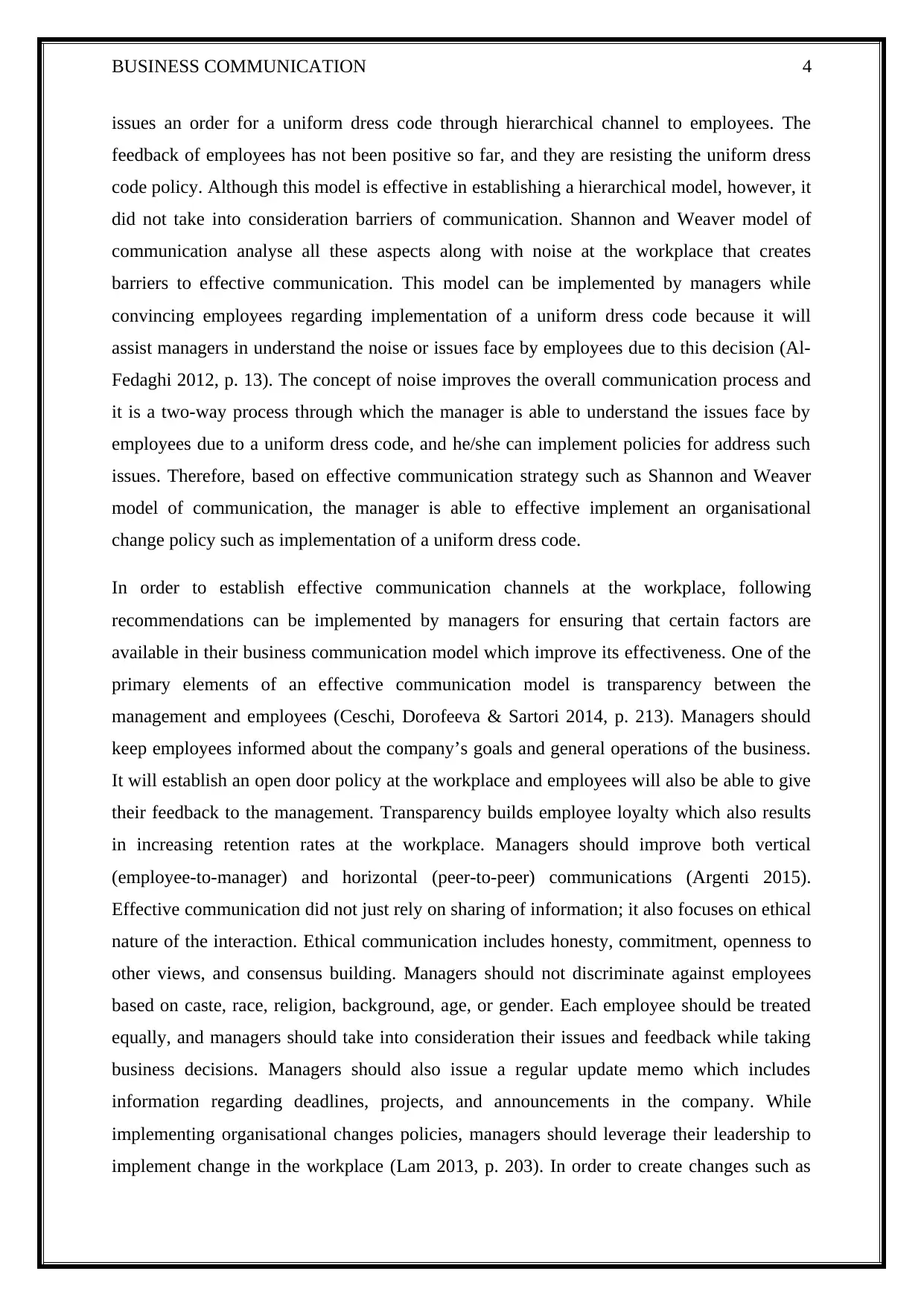
BUSINESS COMMUNICATION 4
issues an order for a uniform dress code through hierarchical channel to employees. The
feedback of employees has not been positive so far, and they are resisting the uniform dress
code policy. Although this model is effective in establishing a hierarchical model, however, it
did not take into consideration barriers of communication. Shannon and Weaver model of
communication analyse all these aspects along with noise at the workplace that creates
barriers to effective communication. This model can be implemented by managers while
convincing employees regarding implementation of a uniform dress code because it will
assist managers in understand the noise or issues face by employees due to this decision (Al-
Fedaghi 2012, p. 13). The concept of noise improves the overall communication process and
it is a two-way process through which the manager is able to understand the issues face by
employees due to a uniform dress code, and he/she can implement policies for address such
issues. Therefore, based on effective communication strategy such as Shannon and Weaver
model of communication, the manager is able to effective implement an organisational
change policy such as implementation of a uniform dress code.
In order to establish effective communication channels at the workplace, following
recommendations can be implemented by managers for ensuring that certain factors are
available in their business communication model which improve its effectiveness. One of the
primary elements of an effective communication model is transparency between the
management and employees (Ceschi, Dorofeeva & Sartori 2014, p. 213). Managers should
keep employees informed about the company’s goals and general operations of the business.
It will establish an open door policy at the workplace and employees will also be able to give
their feedback to the management. Transparency builds employee loyalty which also results
in increasing retention rates at the workplace. Managers should improve both vertical
(employee-to-manager) and horizontal (peer-to-peer) communications (Argenti 2015).
Effective communication did not just rely on sharing of information; it also focuses on ethical
nature of the interaction. Ethical communication includes honesty, commitment, openness to
other views, and consensus building. Managers should not discriminate against employees
based on caste, race, religion, background, age, or gender. Each employee should be treated
equally, and managers should take into consideration their issues and feedback while taking
business decisions. Managers should also issue a regular update memo which includes
information regarding deadlines, projects, and announcements in the company. While
implementing organisational changes policies, managers should leverage their leadership to
implement change in the workplace (Lam 2013, p. 203). In order to create changes such as
issues an order for a uniform dress code through hierarchical channel to employees. The
feedback of employees has not been positive so far, and they are resisting the uniform dress
code policy. Although this model is effective in establishing a hierarchical model, however, it
did not take into consideration barriers of communication. Shannon and Weaver model of
communication analyse all these aspects along with noise at the workplace that creates
barriers to effective communication. This model can be implemented by managers while
convincing employees regarding implementation of a uniform dress code because it will
assist managers in understand the noise or issues face by employees due to this decision (Al-
Fedaghi 2012, p. 13). The concept of noise improves the overall communication process and
it is a two-way process through which the manager is able to understand the issues face by
employees due to a uniform dress code, and he/she can implement policies for address such
issues. Therefore, based on effective communication strategy such as Shannon and Weaver
model of communication, the manager is able to effective implement an organisational
change policy such as implementation of a uniform dress code.
In order to establish effective communication channels at the workplace, following
recommendations can be implemented by managers for ensuring that certain factors are
available in their business communication model which improve its effectiveness. One of the
primary elements of an effective communication model is transparency between the
management and employees (Ceschi, Dorofeeva & Sartori 2014, p. 213). Managers should
keep employees informed about the company’s goals and general operations of the business.
It will establish an open door policy at the workplace and employees will also be able to give
their feedback to the management. Transparency builds employee loyalty which also results
in increasing retention rates at the workplace. Managers should improve both vertical
(employee-to-manager) and horizontal (peer-to-peer) communications (Argenti 2015).
Effective communication did not just rely on sharing of information; it also focuses on ethical
nature of the interaction. Ethical communication includes honesty, commitment, openness to
other views, and consensus building. Managers should not discriminate against employees
based on caste, race, religion, background, age, or gender. Each employee should be treated
equally, and managers should take into consideration their issues and feedback while taking
business decisions. Managers should also issue a regular update memo which includes
information regarding deadlines, projects, and announcements in the company. While
implementing organisational changes policies, managers should leverage their leadership to
implement change in the workplace (Lam 2013, p. 203). In order to create changes such as
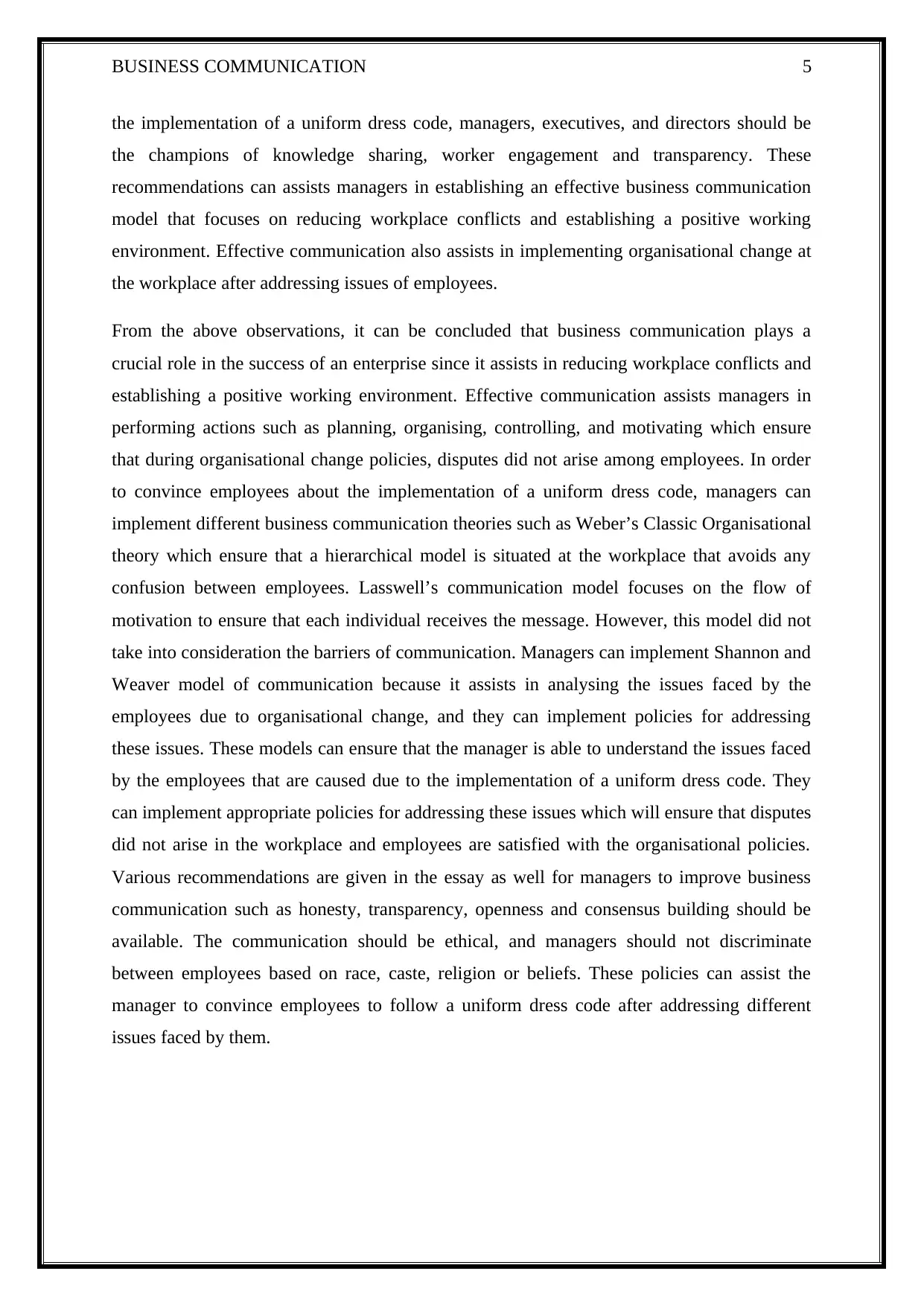
BUSINESS COMMUNICATION 5
the implementation of a uniform dress code, managers, executives, and directors should be
the champions of knowledge sharing, worker engagement and transparency. These
recommendations can assists managers in establishing an effective business communication
model that focuses on reducing workplace conflicts and establishing a positive working
environment. Effective communication also assists in implementing organisational change at
the workplace after addressing issues of employees.
From the above observations, it can be concluded that business communication plays a
crucial role in the success of an enterprise since it assists in reducing workplace conflicts and
establishing a positive working environment. Effective communication assists managers in
performing actions such as planning, organising, controlling, and motivating which ensure
that during organisational change policies, disputes did not arise among employees. In order
to convince employees about the implementation of a uniform dress code, managers can
implement different business communication theories such as Weber’s Classic Organisational
theory which ensure that a hierarchical model is situated at the workplace that avoids any
confusion between employees. Lasswell’s communication model focuses on the flow of
motivation to ensure that each individual receives the message. However, this model did not
take into consideration the barriers of communication. Managers can implement Shannon and
Weaver model of communication because it assists in analysing the issues faced by the
employees due to organisational change, and they can implement policies for addressing
these issues. These models can ensure that the manager is able to understand the issues faced
by the employees that are caused due to the implementation of a uniform dress code. They
can implement appropriate policies for addressing these issues which will ensure that disputes
did not arise in the workplace and employees are satisfied with the organisational policies.
Various recommendations are given in the essay as well for managers to improve business
communication such as honesty, transparency, openness and consensus building should be
available. The communication should be ethical, and managers should not discriminate
between employees based on race, caste, religion or beliefs. These policies can assist the
manager to convince employees to follow a uniform dress code after addressing different
issues faced by them.
the implementation of a uniform dress code, managers, executives, and directors should be
the champions of knowledge sharing, worker engagement and transparency. These
recommendations can assists managers in establishing an effective business communication
model that focuses on reducing workplace conflicts and establishing a positive working
environment. Effective communication also assists in implementing organisational change at
the workplace after addressing issues of employees.
From the above observations, it can be concluded that business communication plays a
crucial role in the success of an enterprise since it assists in reducing workplace conflicts and
establishing a positive working environment. Effective communication assists managers in
performing actions such as planning, organising, controlling, and motivating which ensure
that during organisational change policies, disputes did not arise among employees. In order
to convince employees about the implementation of a uniform dress code, managers can
implement different business communication theories such as Weber’s Classic Organisational
theory which ensure that a hierarchical model is situated at the workplace that avoids any
confusion between employees. Lasswell’s communication model focuses on the flow of
motivation to ensure that each individual receives the message. However, this model did not
take into consideration the barriers of communication. Managers can implement Shannon and
Weaver model of communication because it assists in analysing the issues faced by the
employees due to organisational change, and they can implement policies for addressing
these issues. These models can ensure that the manager is able to understand the issues faced
by the employees that are caused due to the implementation of a uniform dress code. They
can implement appropriate policies for addressing these issues which will ensure that disputes
did not arise in the workplace and employees are satisfied with the organisational policies.
Various recommendations are given in the essay as well for managers to improve business
communication such as honesty, transparency, openness and consensus building should be
available. The communication should be ethical, and managers should not discriminate
between employees based on race, caste, religion or beliefs. These policies can assist the
manager to convince employees to follow a uniform dress code after addressing different
issues faced by them.
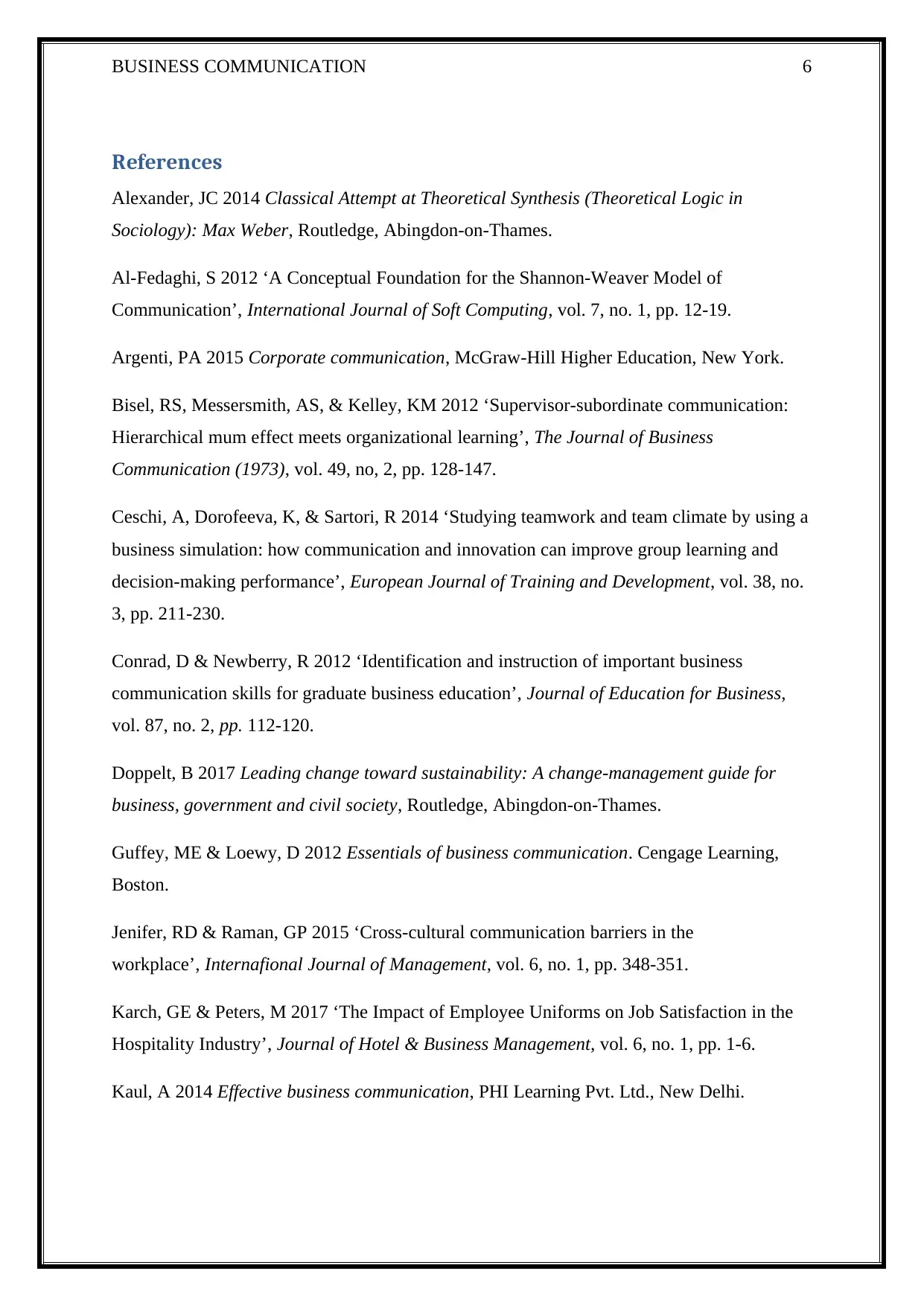
BUSINESS COMMUNICATION 6
References
Alexander, JC 2014 Classical Attempt at Theoretical Synthesis (Theoretical Logic in
Sociology): Max Weber, Routledge, Abingdon-on-Thames.
Al-Fedaghi, S 2012 ‘A Conceptual Foundation for the Shannon-Weaver Model of
Communication’, International Journal of Soft Computing, vol. 7, no. 1, pp. 12-19.
Argenti, PA 2015 Corporate communication, McGraw-Hill Higher Education, New York.
Bisel, RS, Messersmith, AS, & Kelley, KM 2012 ‘Supervisor-subordinate communication:
Hierarchical mum effect meets organizational learning’, The Journal of Business
Communication (1973), vol. 49, no, 2, pp. 128-147.
Ceschi, A, Dorofeeva, K, & Sartori, R 2014 ‘Studying teamwork and team climate by using a
business simulation: how communication and innovation can improve group learning and
decision-making performance’, European Journal of Training and Development, vol. 38, no.
3, pp. 211-230.
Conrad, D & Newberry, R 2012 ‘Identification and instruction of important business
communication skills for graduate business education’, Journal of Education for Business,
vol. 87, no. 2, pp. 112-120.
Doppelt, B 2017 Leading change toward sustainability: A change-management guide for
business, government and civil society, Routledge, Abingdon-on-Thames.
Guffey, ME & Loewy, D 2012 Essentials of business communication. Cengage Learning,
Boston.
Jenifer, RD & Raman, GP 2015 ‘Cross-cultural communication barriers in the
workplace’, Internafional Journal of Management, vol. 6, no. 1, pp. 348-351.
Karch, GE & Peters, M 2017 ‘The Impact of Employee Uniforms on Job Satisfaction in the
Hospitality Industry’, Journal of Hotel & Business Management, vol. 6, no. 1, pp. 1-6.
Kaul, A 2014 Effective business communication, PHI Learning Pvt. Ltd., New Delhi.
References
Alexander, JC 2014 Classical Attempt at Theoretical Synthesis (Theoretical Logic in
Sociology): Max Weber, Routledge, Abingdon-on-Thames.
Al-Fedaghi, S 2012 ‘A Conceptual Foundation for the Shannon-Weaver Model of
Communication’, International Journal of Soft Computing, vol. 7, no. 1, pp. 12-19.
Argenti, PA 2015 Corporate communication, McGraw-Hill Higher Education, New York.
Bisel, RS, Messersmith, AS, & Kelley, KM 2012 ‘Supervisor-subordinate communication:
Hierarchical mum effect meets organizational learning’, The Journal of Business
Communication (1973), vol. 49, no, 2, pp. 128-147.
Ceschi, A, Dorofeeva, K, & Sartori, R 2014 ‘Studying teamwork and team climate by using a
business simulation: how communication and innovation can improve group learning and
decision-making performance’, European Journal of Training and Development, vol. 38, no.
3, pp. 211-230.
Conrad, D & Newberry, R 2012 ‘Identification and instruction of important business
communication skills for graduate business education’, Journal of Education for Business,
vol. 87, no. 2, pp. 112-120.
Doppelt, B 2017 Leading change toward sustainability: A change-management guide for
business, government and civil society, Routledge, Abingdon-on-Thames.
Guffey, ME & Loewy, D 2012 Essentials of business communication. Cengage Learning,
Boston.
Jenifer, RD & Raman, GP 2015 ‘Cross-cultural communication barriers in the
workplace’, Internafional Journal of Management, vol. 6, no. 1, pp. 348-351.
Karch, GE & Peters, M 2017 ‘The Impact of Employee Uniforms on Job Satisfaction in the
Hospitality Industry’, Journal of Hotel & Business Management, vol. 6, no. 1, pp. 1-6.
Kaul, A 2014 Effective business communication, PHI Learning Pvt. Ltd., New Delhi.
Paraphrase This Document
Need a fresh take? Get an instant paraphrase of this document with our AI Paraphraser
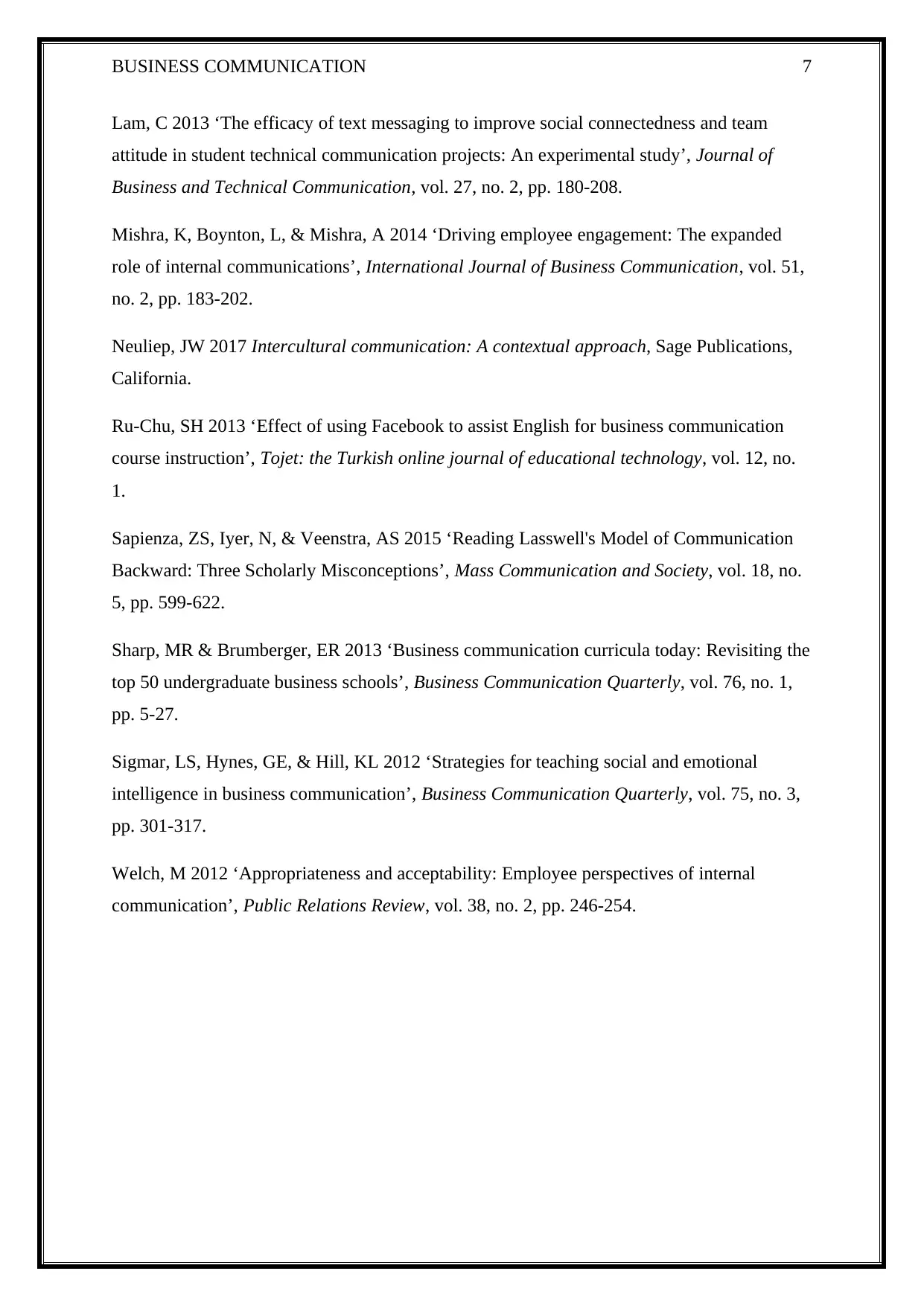
BUSINESS COMMUNICATION 7
Lam, C 2013 ‘The efficacy of text messaging to improve social connectedness and team
attitude in student technical communication projects: An experimental study’, Journal of
Business and Technical Communication, vol. 27, no. 2, pp. 180-208.
Mishra, K, Boynton, L, & Mishra, A 2014 ‘Driving employee engagement: The expanded
role of internal communications’, International Journal of Business Communication, vol. 51,
no. 2, pp. 183-202.
Neuliep, JW 2017 Intercultural communication: A contextual approach, Sage Publications,
California.
Ru-Chu, SH 2013 ‘Effect of using Facebook to assist English for business communication
course instruction’, Tojet: the Turkish online journal of educational technology, vol. 12, no.
1.
Sapienza, ZS, Iyer, N, & Veenstra, AS 2015 ‘Reading Lasswell's Model of Communication
Backward: Three Scholarly Misconceptions’, Mass Communication and Society, vol. 18, no.
5, pp. 599-622.
Sharp, MR & Brumberger, ER 2013 ‘Business communication curricula today: Revisiting the
top 50 undergraduate business schools’, Business Communication Quarterly, vol. 76, no. 1,
pp. 5-27.
Sigmar, LS, Hynes, GE, & Hill, KL 2012 ‘Strategies for teaching social and emotional
intelligence in business communication’, Business Communication Quarterly, vol. 75, no. 3,
pp. 301-317.
Welch, M 2012 ‘Appropriateness and acceptability: Employee perspectives of internal
communication’, Public Relations Review, vol. 38, no. 2, pp. 246-254.
Lam, C 2013 ‘The efficacy of text messaging to improve social connectedness and team
attitude in student technical communication projects: An experimental study’, Journal of
Business and Technical Communication, vol. 27, no. 2, pp. 180-208.
Mishra, K, Boynton, L, & Mishra, A 2014 ‘Driving employee engagement: The expanded
role of internal communications’, International Journal of Business Communication, vol. 51,
no. 2, pp. 183-202.
Neuliep, JW 2017 Intercultural communication: A contextual approach, Sage Publications,
California.
Ru-Chu, SH 2013 ‘Effect of using Facebook to assist English for business communication
course instruction’, Tojet: the Turkish online journal of educational technology, vol. 12, no.
1.
Sapienza, ZS, Iyer, N, & Veenstra, AS 2015 ‘Reading Lasswell's Model of Communication
Backward: Three Scholarly Misconceptions’, Mass Communication and Society, vol. 18, no.
5, pp. 599-622.
Sharp, MR & Brumberger, ER 2013 ‘Business communication curricula today: Revisiting the
top 50 undergraduate business schools’, Business Communication Quarterly, vol. 76, no. 1,
pp. 5-27.
Sigmar, LS, Hynes, GE, & Hill, KL 2012 ‘Strategies for teaching social and emotional
intelligence in business communication’, Business Communication Quarterly, vol. 75, no. 3,
pp. 301-317.
Welch, M 2012 ‘Appropriateness and acceptability: Employee perspectives of internal
communication’, Public Relations Review, vol. 38, no. 2, pp. 246-254.
1 out of 8
Your All-in-One AI-Powered Toolkit for Academic Success.
+13062052269
info@desklib.com
Available 24*7 on WhatsApp / Email
![[object Object]](/_next/static/media/star-bottom.7253800d.svg)
Unlock your academic potential
© 2024 | Zucol Services PVT LTD | All rights reserved.



